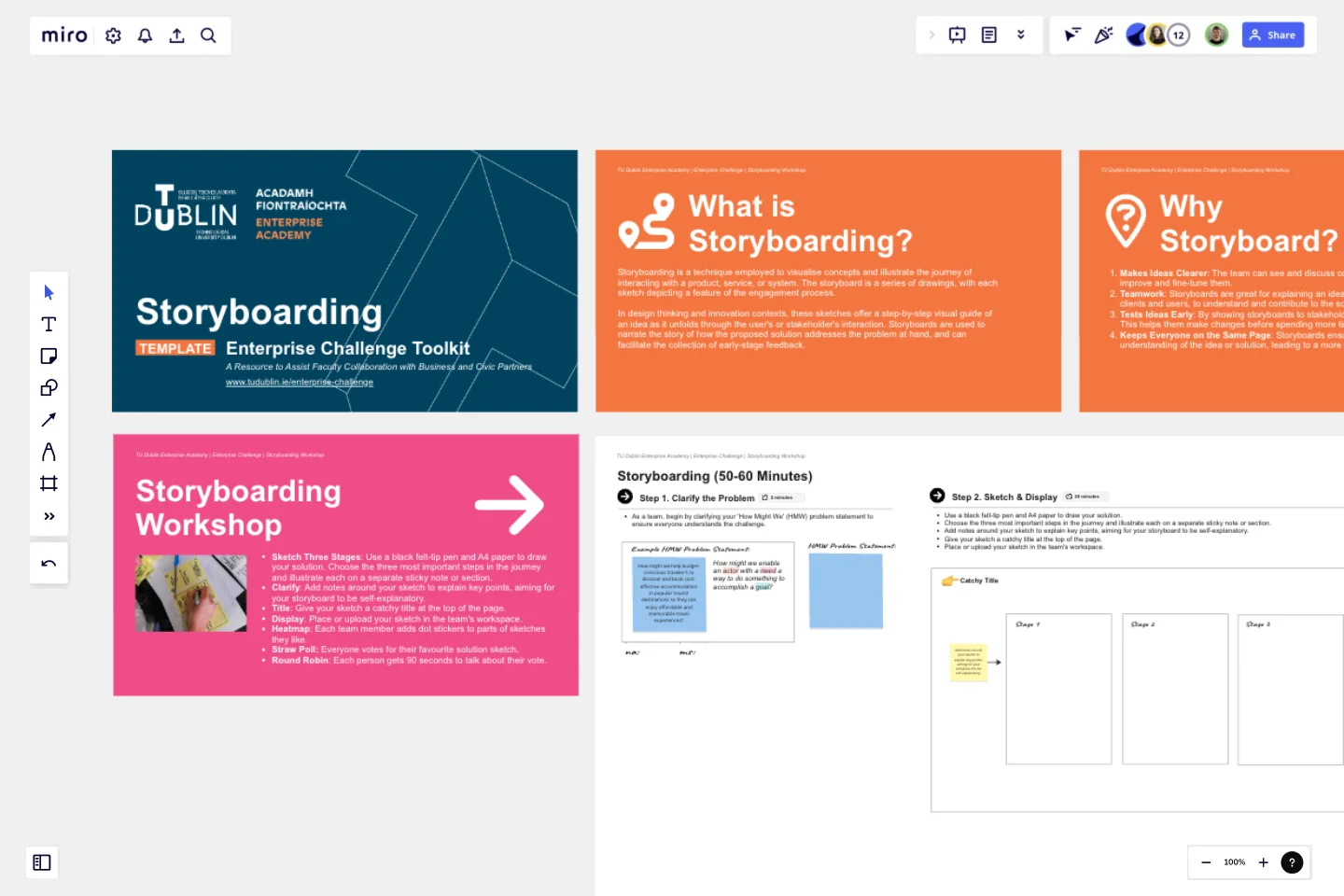The Storyboarding Workshop Template
Storyboards are typically developed either at the end of the Ideation phase or at the start of the Prototype phase.
By visually detailing the ideas, storyboards allow for a clearer understanding and assessment of each proposed solution's potential and practicality.
When to Use
Storyboards are typically developed either at the end of the Ideation phase or at the start of the Prototype phase. By visually detailing the ideas, storyboards allow for a clearer understanding and assessment of each proposed solution's potential and practicality.
How to Use
Sketch Three Stages: Use a black felt-tip pen and A4 paper to draw your solution. Choose the three most important steps in the journey and illustrate each on a separate sticky note or section.
Clarify: Add notes around your sketch to explain key points, aiming for your storyboard to be self-explanatory.
Title: Give your sketch a catchy title at the top of the page.
Display: Place or upload your sketch in the team's workspace.
Heatmap: Each team member adds dot stickers to parts of sketches they like.
Straw Poll: Everyone votes for their favourite solution sketch.
Round Robin: Each person gets 90 seconds to talk about their vote.
Use the vote and discussion to select one sketch for further detailed storyboarding or prototyping.
This template was created by Niamh O'Hora. Discover more storyboard template examples and map your next project.
Get started with this template right now.
Fiction Storyboard
Works best for:
Storyboard, Planning, Design
Unleash your creativity with the Fiction Storyboard template. Perfect for writers and storytellers, this template helps you map out your fictional narratives, including plot points, character arcs, and scene transitions. It provides a structured framework to visualize your story's progression and ensure consistency. Use it to organize your ideas, explore different storylines, and create a compelling narrative that captivates your audience from start to finish.
Agile Kata Storyboard
Works best for:
Storyboard, Design, Planning
Optimize your Agile processes with the Agile Kata Storyboard template. This template is ideal for Agile teams looking to improve their workflows and problem-solving techniques. It helps you visualize the steps of the Agile Kata, including problem identification, solution brainstorming, and iterative testing. Use this template to facilitate continuous improvement, enhance team collaboration, and ensure your Agile practices are effective and efficient.
User Flows
The User Flows template offers a visual tool for mapping out the sequence of steps that users take to accomplish a specific task or achieve a goal within a digital product or service. It provides elements for documenting user interactions, screens, and decision points along the user journey. This template enables UX designers and product teams to understand user behaviors, identify pain points, and optimize the user experience effectively. By promoting user-centric design and empathy, the User Flows template empowers teams to create intuitive and engaging digital experiences that meet user needs and drive satisfaction.
Buyer Persona Template
Works best for:
Marketing, Desk Research, User Experience
You have an ideal customer: The group (or few groups) of people who will buy and love your product or service. But to reach that ideal customer, your entire team or company has to align on who that is. Buyer personas give you a simple but creative way to get that done. These semi-fictional representations of your current and potential customers can help you shape your product offering, weed out the “bad apples,” and tailor your marketing strategies for serious success.
Product Development Roadmap Template
Works best for:
Product Management, Software Development
Product development roadmaps cover everything your team needs to achieve when delivering a product from concept to market launch. Your product development roadmap is also a team alignment tool that offers guidance and leadership to help your team focus on balancing product innovation and meeting your customer’s needs. Investing time in creating a roadmap focused on your product development phases helps your team communicate a vision to business leaders, designers, developers, project managers, marketers, and anyone else who influences meeting team goals.
Visual Prototyping Template
Visual and emotional aspects play a vital role in determining a product or service's usability and user experience. To evaluate these aspects of your proposed solution, consider using the Visual Prototyping Template. By creating a model that closely resembles the real product or service, and gathering feedback from key stakeholders, you can assess whether the form of your creation is advantageous or detrimental.
